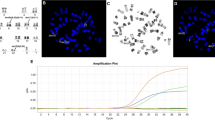Abstract
Patients with acute promyelocytic leukemia (APL) show other chromosome aberrations in addition to t(15;17) but their influence on the clinical outcome is still unclear. We have cytogeneticaly analyzed 43 APL patients with t(15;17)(q22;q21), treated with all-trans-retionic acid (ATRA) according to the recommendations of the European APL 91 Group. Additional chromosome aberrations were observed in 14/43 patients (33%) studied at initial diagnosis. These patients were designed as ‘complex’ karyotype group and were compared to patients with t(15;17) as a sole cytogenetic abnormality (‘simple’ karyotype group). The ‘complex’ group had significantly lower platelet count and fibrinogen level and fewer cases without significant DIC at diagnosis than the ‘simple’ group. Comparison of ‘simple’ and ‘complex’ groups showed significant difference in complete remission rate (76%vs 35.7%,P=0.0148) and early death rate (24%vs 64.3%,P=0.0141). Survival analysis showed that the presence of additional chromosome abnormalities and significant DIC had an adverse effects on prognosis (P=0.036 andP=0.041, respectively), independent on other prognostic factors. These data indicate more aggressive biological nature of leukemic cells in patients with additional chromosome aberrations. Supplementary therapeutic strategies may be required for this subgroup of APL patients.
Similar content being viewed by others
References
Castaigne Set al. All trans retinoic acid as a differentiation therapy for acute promyelocytic leukemia. I. Clinical results.Blood 1990;76: 1704–1709.
Chen Z, Differentiation therapy of acute promyelocytic leukemia.Chin Med J 1996;109: 179–192.
Slack JL, Gallagher RE. The molecular biology of acute promyelocytic leukemia.Cancer Treat Res 1999;99: 75–124.
Wan TSet al. Complex variant 15;17 translocation in acute promyelocytic leukemia. A case report and review of three-way translocations.Cancer Genet Cytogenet 1999;111: 139–143.
Berger Ret al. Cytogenetic studies in acute promyelocytic leukemia: a survey of secondary chromosomal abnormalities.Genes, Chromosomes Cancer 1991;3: 332–337.
Grimwade Det al. Establishing the presence of the t(15;17) in suspected acute promyelocytic leukemia: cytogenetic, molecular and PML immunofluorescence assessment of patients entered into the MRT ATRA Trial.Br J Haematol 1996;94: 557–573.
Hiorns Let al. Additional chromosome abnormalities confer worse prognosis in acute promyelocytic leukemia.Br J Haematol 1997;96: 314–321.
Schoch Cet al. Incidence and implication of additional chromosome aberration in acute promyelocytic leukemia with translocation t(15:17)(q22:q21): a report on 50 patients.Br J Haematol 1996;94: 493–500.
Slack JLet al. Secondary cytogenetic changes in acute promyelocytic leukemia—prognostic importance in patients treated with chemotherapy alone and association with the intron 3 breakpoint of the PML gene: a Cancer and Leukemia Group B study.J Clin Oncol 1997;15: 1786–1795.
Bennet JMet al. Proposals for the classification of the acute leukemias.Br J Haematology 1976;33: 451–458.
Colovic MDet al. Effect of all-trans-retinoic acid alone or in combination with chemotherapy in newly diagnosed acute promyelocytic leukemia.Med Oncol 1997;14: 65–72.
Fenaux Pet al. Effect of all trans retinoic acid in newly diagnosed acute promyelocytic leukemia. Results of a multicenter randomized trial.Blood 1993;82: 3241–3249.
Novak A, Kruskic M, Ludoski M, Jurukovski V. Rapid method for obtaining high quality chromosome banding in the study of hemopoietic neoplasia.Cancer Genet Cytogenet 1994;74: 109–114.
Mitelman F.ISCN, An International System for Human Cytogenetic Nomenclature. Karger: Basel, 1995.
Kaplan E, Meier P. Nonparametric estimation from incomplete observation.Am Statist Assoc J 1956;53: 456–481.
Peto Ret al. Design and analysis of randomized clinical trials requiring prolonged observation of each patient. II. Analysis and examples.Br J Cancer 1977;35: 1–39.
Cox DR. Regression models and life tables,J R Statist Soc 1972;34: 182–202.
Rieder Het al. Prognostic significance of additional chromosome abnormalities in adult patients with Philadelphia chromosome positive acute lymphoblastic leukemia.Br J Haematol 1996;95: 678–691.
Sessarego Met al. High frequency of trisomy 8 in acute promyelocytic leukemia: a fluorescence in situ hybridization study.Cancer Genet Cytogenet 1997;97: 161–164.
Schoch Cet al. The significance of trisomy 8 inde novo acute myeloid leukemia: the accompanying chromosome aberrations determine the prognosis. German AML Cooperative Study Group.Br J Haematol 1997;99: 605–611.
Kaleem Zet al. Acute promyelocytic leukemia with additional chromosomal abnormalities and absence of Auer rods.Am J Clin Pathol 1999;112: 113–118.
Huang Wet al. Acute promyelocytic leukemia: clinical relevance of two major PML-RARα isoforms and detection of minimal residual disease by retrotranscriptase/polymerase chain reaction to predict relapse.Blood 1993;82: 1264–1269.
Vahdat Let al. Early mortality and the retinoic acid syndrome in acute promyelocytic leukemia: impact of leukocytosis, low-dose chemotherapy, PML-RARα isoform and CD13 expression in patients treated with all-trans retinoic acid.Blood 1994;84: 3843–3849.
Author information
Authors and Affiliations
Rights and permissions
About this article
Cite this article
Pantic, M., Novak, A., Marisavljevic, D. et al. Additional chromosome aberrations in acute promyelocytic leukemia: characteristics and prognostic influence. Med Oncol 17, 307–313 (2000). https://doi.org/10.1007/BF02782196
Received:
Accepted:
Published:
Issue Date:
DOI: https://doi.org/10.1007/BF02782196




